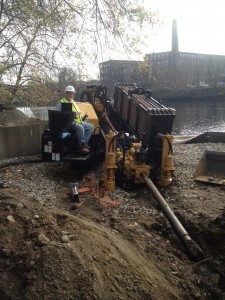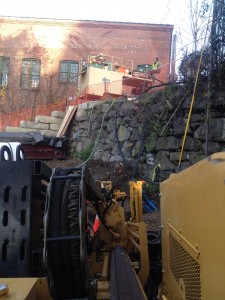Horizontal LNAPL Recovery in New England
Following the acquisition of DTD’s new Vermeer 36x50DR horizontal drill rig, we recently put it to the test by installing a 300′ horizontal drain in Connecticut. The drain was installed under a former industrial facility (resting on a granite block footer to unknown depth) located along a local river.
In its current state, the building operated as a hydroelectric plant by directing water flowing from an adjacent canal into the tail race beneath the building (powering the turbines), eventually discharging downstream into a river. Regulating agencies halted power generation as a fuel oil plume located underneath the building was being drawn into the turbines and discharging to the river. The drain will be used as a conduit to divert the oil away from the tail race in an attempt to again permit hydroelectric generation at this facility.
DTD began this project with a 24x40a drill rig, but subsurface materials prevented advancement of a conventional jetting assembly. Stepping up our technology to meet this challenge, we mobilized our new Vermeer 36x50DR directional drill rig to complete the bore. Utilizing dual rod technology, Vermeer has designed a mechanical, dual-rod system on the 36×50 platform to allow the drill bit to spin independently of the drill stem. This system differs from a conventional mud motor that uses high mud flow to hydraulically turn the drill bit independently of the drill stem. Conditions present at this facility called for technology that was beyond conventional due to the local geology (cobbles, boulders), a granite block retaining wall to unknown depth, three granite block footers, and various site contsraints (small drill rig footprint, maximum bend radius of entry and exit curves, etc.).
The drain was designed to be double-ended and the exit was positioned ~300′ to the west and 25′ above the entry location. The 36x50DR proved to be ideal to complete the pilot bore and reaming pass, surmounting the aforementioned non-ideal conditions.
Even with the use of the 36×50, the unstable ground presented a final challenge for the project. The last step of completion involved pulling the 6-inch stainless steel well materials through the bore. While pulling back, unstable fill beneath the edge of the foundation, crushed a portion of the end of the stainless steel well Screen. After discussions with the owner and consultant, it was decided to use specialized tooling to the sever the “stuck” well materials near the point of collapse leaving ~230 feet in place. Four inch stainless well materials (riser and screen) were then pulled through the inside of the 6-inch materials and through the collapsed section, completing the installation of the drain.

